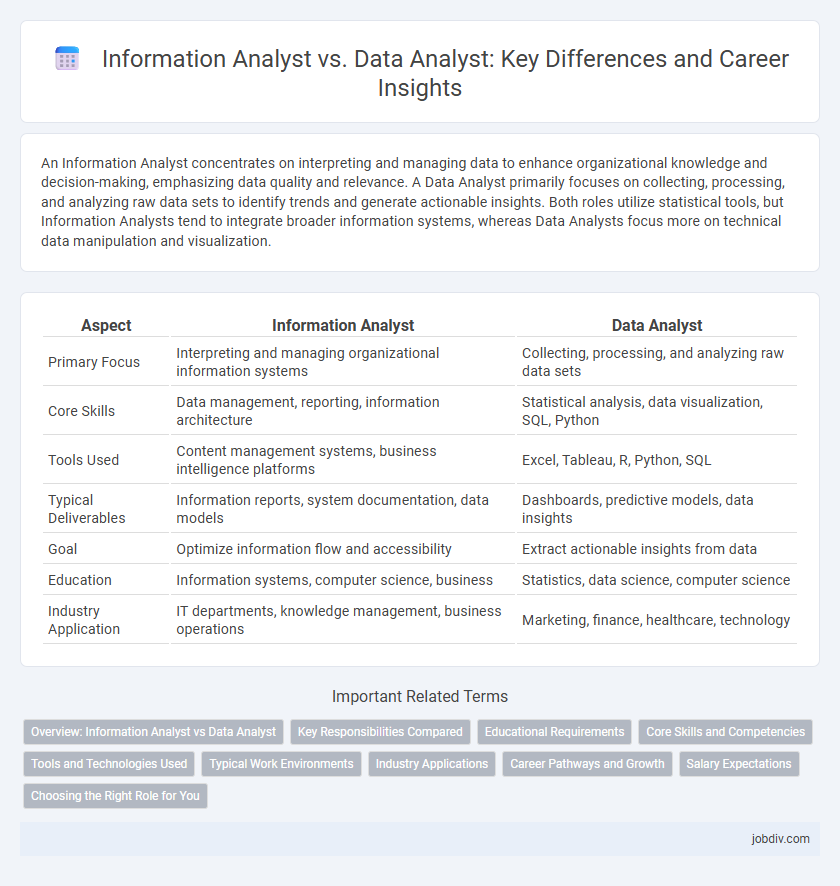An Information Analyst concentrates on interpreting and managing data to enhance organizational knowledge and decision-making, emphasizing data quality and relevance. A Data Analyst primarily focuses on collecting, processing, and analyzing raw data sets to identify trends and generate actionable insights. Both roles utilize statistical tools, but Information Analysts tend to integrate broader information systems, whereas Data Analysts focus more on technical data manipulation and visualization.
Table of Comparison
| Aspect | Information Analyst | Data Analyst |
|---|---|---|
| Primary Focus | Interpreting and managing organizational information systems | Collecting, processing, and analyzing raw data sets |
| Core Skills | Data management, reporting, information architecture | Statistical analysis, data visualization, SQL, Python |
| Tools Used | Content management systems, business intelligence platforms | Excel, Tableau, R, Python, SQL |
| Typical Deliverables | Information reports, system documentation, data models | Dashboards, predictive models, data insights |
| Goal | Optimize information flow and accessibility | Extract actionable insights from data |
| Education | Information systems, computer science, business | Statistics, data science, computer science |
| Industry Application | IT departments, knowledge management, business operations | Marketing, finance, healthcare, technology |
Overview: Information Analyst vs Data Analyst
Information analysts primarily focus on interpreting and managing structured and unstructured data to support strategic decision-making, often integrating insights from various data sources. Data analysts concentrate on extracting, cleaning, and analyzing quantitative data sets to identify trends, patterns, and actionable metrics within specific business domains. Both roles require strong analytical skills and proficiency in data tools but differ in scope, with information analysts typically addressing broader organizational knowledge management and data analysts emphasizing technical data manipulation and reporting.
Key Responsibilities Compared
Information Analysts primarily focus on interpreting and managing organizational information to improve decision-making, emphasizing data collection, data quality assessment, and information system optimization. Data Analysts concentrate on analyzing quantitative data sets using statistical tools, data visualization, and reporting to uncover trends and support business strategies. Both roles require strong analytical skills, but Information Analysts prioritize information management frameworks, while Data Analysts emphasize data manipulation and predictive analytics.
Educational Requirements
Information Analysts typically require a bachelor's degree in information systems, computer science, or a related field, often supplemented by certifications in data management or business intelligence. Data Analysts usually hold degrees in statistics, mathematics, computer science, or economics, emphasizing strong quantitative and analytical skills. Both roles benefit from advanced training in data visualization tools, programming languages like Python or R, and knowledge of database technologies.
Core Skills and Competencies
Information Analysts excel in interpreting complex datasets and transforming raw information into actionable insights through strong data visualization and reporting skills. Data Analysts focus on statistical analysis, data cleaning, and coding proficiency in tools like SQL, Python, or R to extract and manipulate large datasets for business intelligence purposes. Both roles require critical thinking, attention to detail, and strong communication skills to effectively convey findings to stakeholders.
Tools and Technologies Used
Information Analysts primarily utilize tools such as Microsoft Excel, SQL, and business intelligence platforms like Tableau and Power BI to interpret and present data for decision-making. Data Analysts often work with statistical software including R, Python, and SAS, alongside data management tools like Hadoop and Apache Spark to process large datasets. Both roles leverage data visualization and database querying technologies, but Data Analysts typically engage more deeply with advanced programming and big data frameworks.
Typical Work Environments
Information Analysts typically work in corporate settings, government agencies, or consulting firms where they analyze and optimize information flow and data usage. Data Analysts are often found in sectors like finance, healthcare, marketing, and technology, focusing on data collection, statistical analysis, and reporting to support decision-making. Both roles frequently utilize office environments equipped with advanced software tools, yet Data Analysts may also engage in more collaborative, project-based settings involving cross-functional teams.
Industry Applications
Information analysts specialize in interpreting complex data sets to improve organizational decision-making processes within sectors such as healthcare, finance, and government. Data analysts focus on extracting actionable insights from raw data using statistical tools and software, with applications in marketing, retail, and manufacturing industries. Both roles leverage industry-specific data models and analytics platforms to drive operational efficiency and strategic planning.
Career Pathways and Growth
Information Analysts primarily focus on interpreting data to improve business processes and make strategic decisions, often progressing towards roles like Information Manager or Business Intelligence Specialist. Data Analysts concentrate on collecting, processing, and performing statistical analyses on datasets, with career growth leading to positions such as Data Scientist or Analytics Manager. Both career pathways emphasize advanced technical skills and domain knowledge, offering robust opportunities for specialization and leadership in data-driven environments.
Salary Expectations
Information Analyst roles typically offer salaries ranging from $60,000 to $85,000 annually, reflecting responsibilities centered on managing and interpreting information systems. Data Analysts often command higher salaries, between $65,000 and $95,000, due to their focus on data mining, statistical analysis, and predictive modeling. Salary variations depend on factors such as industry, geographic location, and level of experience within each analytical domain.
Choosing the Right Role for You
Information Analysts specialize in interpreting structured and unstructured data to improve business decisions, focusing on information systems and content analysis. Data Analysts primarily handle quantitative data, utilizing statistical tools and coding languages like SQL and Python to extract actionable insights from datasets. Choosing the right role depends on your preference for managing information flows and strategic insights versus performing detailed data manipulation and statistical analysis.
Information Analyst vs Data Analyst Infographic

 jobdiv.com
jobdiv.com